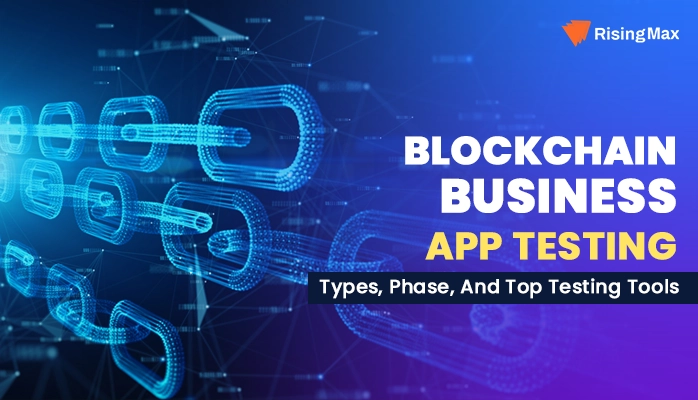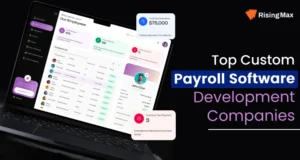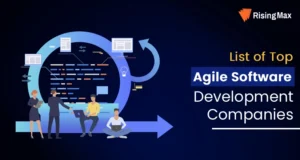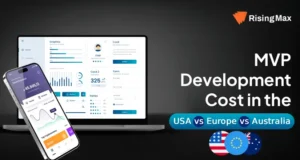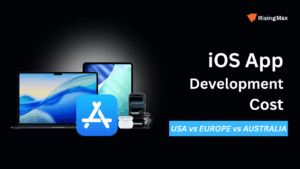Businesses’ goal of safely and securely storing confidential data has become a reality with the advent of blockchain technology. For this very reason, various industries, like finance, real estate, healthcare, insurance, etc, are developing and implementing blockchain-based business solutions and moving toward a secure ecosystem.

Blockchain-powered solutions store business data inside blocks and encrypt them increasing the security of valuable and critical data.
Although during the early inception years, blockchain technology was associated with Bitcoin and cryptocurrencies. However, this perception has evolved over the years, and we are now seeing widespread blockchain use cases across various industries.
In an era where blockchain technology continues to rise exponentially with no visible sign of decelerating. Improper implementation, blockchain app testing, and maintenance result in security concerns and other related issues.
Are you planning to build your own blockchain-powered business application? Then, reach out to our experts at RisingMax Inc. We offer end-to-end blockchain development services, from app consultation to development, testing, and maintenance services. Schedule a FREE consultation call and discuss your blockchain project idea with our experts TODAY!
Before delving deep into the topic, let’s first understand blockchain and the different types of blockchain solutions. And then move forward with the blockchain app testing process, testing types, and top blockchain testing tools.
What and Why Blockchain Technology?
Blockchain technology is basically a database where data or information is stored in “blocks,” and the previous block verifies the information to form a continuous chain. Thus, earning the name – blockchain technology.
In addition to this, blockchain technology uses a decentralized digital ledger to ensure that each chain has the same copy. Once a chain is verified and created, it cannot be deleted, modified, or recalled. Thus, creating a transparent ecosystem for everyone and ensuring the security of critical business data.
Now that you have understood the what and why of blockchain technology, let’s move further and discuss different types.
Four Types of Blockchain Technology: Public, Private, Permissioned, or Consortium Blockchain
Public Blockchain Network
As the name suggests, it is an open public network on blockchain, and anyone can become part of this network. Public participants can read, write, and edit ongoing activities within the network.
If you are planning to build an application on the public blockchain network, you need to keep in mind no privacy, high transparency, and weak security. Ensure your QA team keeps all these parameters in mind and tests blockchain applications accordingly.
Private Blockchain Network
In this type of blockchain network, one or a group of entities of the same organization control, execute and maintain the blockchain network. A high level of privacy, weak transparency (as information access can be limited), and enhanced security, are some of the key attributes of the private blockchain network. If you are planning to build an application on a private blockchain network, then make sure you keep these parameters in mind.
Permissioned Blockchain Network
If you have understood the above two mentioned blockchain networks, then, a permissioned blockchain network is a combination of the two. It is a hybrid blockchain network that allows admins to limit or open access to information to participants within the network. The permissioned blockchain network is a preferred option for small and medium enterprises for developing blockchain-based applications.
Consortium Blockchain Network
This type of blockchain network is an advanced version of the private blockchain network. A group of individuals and admins network widens information reach, enhances transparency, and improves accountability. This type of blockchain network is more suitable for developing apps for MNC and enterprise-level businesses.
So, now you have understood different types of blockchain networks and which one is perfect for building your own business application. Let’s dig deep into the topic and understand blockchain testing and various other associated parameters.
What is Blockchain Testing?
Similar to any software application development, blockchain-powered business solutions require testing to validate operations before deploying in real-world business scenarios.
Blockchain technology has been around for quite some time now, and QA service providers are deploying testing tools, software, and methodologies to ensure high-end solutions.
Based on industries’ different blockchain-powered solutions, such as smart contracts, crypto wallets, DEx, DAO, and other software, are built and require validation. Our QA team ensures that the blockchain app functions as expected and validates all testing parameters.
The core objective of blockchain testing is to test an application under different conditions, ensuring quality blockchain solutions for businesses.
Types of Blockchain Testing
There are different types of blockchain testing solutions with a common goal of finding loopholes and testing applications under various conditions. Here in this section, we are going to discuss various types of blockchain testing in detail.
Functional Testing
As the name suggests, the QA team verifies all the functional operations of the blockchain application without looking into the internal app structure. No coding knowledge is required, as the main focus is to ensure compliance with what blockchain application does.
Some of the common components of functional testing include;
- Integration testing.
- Unit testing.
- Smoke testing.
- Regression testing.
Performance Testing
During this testing stage, the QA team tests the performance and speed of the application under expected working conditions and workload. With this, the testing team ensures blockchain-based applications’ speed, scalability, and reliability.
A detailed report is submitted identifying areas of improvement and performance issues of the blockchain applications. The blockchain application’s testing area scope depends upon the network’s size and functions.
Security Testing
The QA team identifies security loopholes and vulnerabilities of the blockchain app within the network, client side, and admin side. The QA team will test and analyze every aspect of the blockchain app. A detailed testing report highlighting risks, threats, and areas of improvement in the system will be highlighted.
The security testing team ensures that the blockchain application creates a secure and transparent ecosystem for carrying out transactions and other business operations.
Cycle Testing
Blockchain works on consensus mechanisms, and in cycle testing, the QA team verifies the same. The team ensures that the consensus protocols are working as expected and each transaction within the network is stored in proper order.
Node Testing
The team, while testing the blockchain application, tests every node independently. The main objective during the node testing phase is to ensure accurate record-keeping and a risk-free connection within each network participant.
Smart Contracts Testing
These are computer-coded contracts or conditions that execute automatically when all pre-set conditions are met. The role of the QA team is to find loopholes within the smart contract that can be exploited or result in the wrong execution of the transaction. The testing team executes the smart contract under real-world conditions and tests its effectiveness.
API Testing
Based on the type of blockchain application, APIs are integrated and responsible for app interaction both inside and outside the blockchain network. The main responsibility of the QA team is to find loopholes in security threats API possesses to the internal and external applications.
Integration Testing
During this testing process, the QA team tested various integrated parts of the system to ensure smooth working. A detailed testing report is submitted indicating all blockchain application components are properly integrated and working as intended.
Align the current state of IT with your business strategy by hiring the most trustworthy Blockchain Development Company
Different Phases of Blockchain Testing
During the testing stage, blockchain applications step-wise goes through different testing phases. Each testing phase has its own goals and expected outcomes. In this section, we will discuss different phases of blockchain testing in detail. So, keep on reading for a better understanding and gain valuable insights about blockchain testing.
Blockchain Testing Phase 1: Discovery
During this phase, the QA team analyzes the structure of the blockchain app, any legal compliance, and in-depth application work. With a clear project understanding, the QA team prepares a testing roadmap and implements testing methodologies to ensure application compliance.
Blockchain Testing Phase 2: Evaluation
The observation made during the first step will lay the foundation of the second blockchain testing phase i.e. Evaluation. During this stage, the testing team prepares a targeted roadmap to put vulnerabilities or potential loopholes under the test to drive meaningful outcomes.
Blockchain Testing Phase 3: Testing
During this blockchain app testing phase, the QA team follows the roadmap created and tests various aspects of the applications. The application goes through performance, functional, API, and other testing phases to ensure the blockchain applications’ reliability, security, and bug-free deployment.
Blockchain Testing Phase 4: Test Report
After the completion of the testing phase, the QA team submits the observation or areas of improvement of the blockchain app. A detailed testing report makes it easy for the development team to make necessary changes and the cyber security team to take necessary action against security loopholes.
Blockchain Testing Phase 5: Rectify and Submit for a Re-scan
With a detailed testing report in hand, the development team will take necessary actions to rectify loopholes and make necessary changes. After rectifying all the loopholes or bugs reported, the application will again be submitted for re-scan.
Top Blockchain Testing Tools For Business Applications
Now, you clearly understand the types of blockchain testing and different phases. Let’s move ahead and talk about the top blockchain testing tools available in the market today.
Truffle Suite
Equipped with highly advanced features such as automated testing and many more, this is one of the go-to testing frameworks for QA teams working with Ethereum apps. One of the biggest advantages of the Truffle suite is that QA experts can write simple and manageable test reports, even in Javascript and Solidity.
Ethereum Tester
As Ethereum is a popular blockchain technology for developing blockchain apps, most QA teams prefer the Ethereum tester framework. From smart contracts to APIs and web3 integration, this framework offers support for carrying out blockchain testing. In addition to this, its ability to mimic blockchain production allows developers and testers to simulate scenarios and carry out blockchain app testing.
Brownie
This testing framework is based on pytest framework, which makes it easy to use and extremely popular among developers and testers worldwide. The Ethereum testing capabilities enable QA teams to test contract deployment.
Blockapps Strato
The wide range of testing services Blockapps Strato offers makes it extremely popular among blockchain testing teams. The integrated debugging tools make it easy to find security loopholes and technical issues with blockchain applications.
Ganache (Testrpc)
When it comes to testing Ethereum-based contracts, no testing tool can match the efficiency of the Ganache tool. Various testing scenarios can be created to test the application in a virtual environment rather than in actual occurrence.
Manticore
From program exploration to error detection and input generation, Manticore testing tools have various high-end features. It is a symbolic execution tool that can be deployed for testing smart contracts, and modules and performing binary analysis.
BitcoinJ
This testing tool is ideal for testing blockchain applications built using the Bitcoin protocol. The wide-ranging capabilities of BitcoinJ, from Java to JVM-compatible languages such as Python or JavaScript, make it a popular testing framework.
Exonum Testkit
When it comes to testing APIs integration and execution of transactions on a blockchain network, Exonum Testkit is a perfect tool. Most QA testing teams deploy this for blockchain application activity.

Why Choose Us for Testing Blockchain-Based Business Solutions?
RisingMax Inc., a well-recognized blockchain testing services provider, assists businesses worldwide in testing blockchain apps before deployment. Irrespective of the business domain, our QA team ensures that business apps meet all industry quality standards and are at par with changing technology trends.
Here’s why you hire us;
- Unmatched blockchain expertise.
- Cost-effective blockchain testing services.
- Customized testing methodologies.
- Highly experienced and certified QA team.
- Transparent pricing policy.
- 24*7 customer support.
Connect over a FREE business consultation call and discuss your blockchain app testing needs with our experts TODAY!

